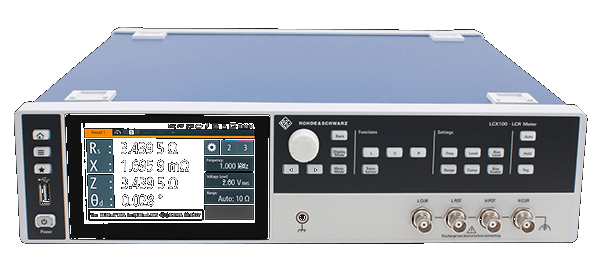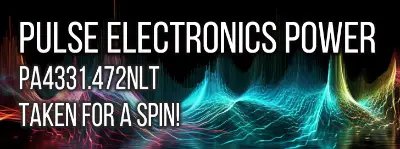KEMET's C1210C476M4PAC7210: A Comprehensive Review of a 47μF Ceramic X5R Capacitor
By Mark Harris Thursday, 20 April 2023

Introduction
Allow us to introduce the KEMET C1210C476M4PAC7210 capacitor, a component with a 47μ nominal value, a ±20% tolerance, a voltage rating of 16V, and a composition of the renowned Ceramic: X5R. With its surface mount package meeting the 1210 (3225 Metric) standard, this capacitor seemingly blends seamlessly into a multitude of applications.
In terms of performance, one of the most important factors to consider in a capacitor is the benchmark comparison, which enables engineers to decide if it is indeed the optimal choice for their needs. Analyzing the KEMET C1210C476M4PAC7210 capacitor's performance against statistical benchmark data will provide valuable insights for those making this consideration. The review breakdown upon which numerous topics featured include: Capacitance, Series Resistance, Dissipation Factor, and Quality Factor, Comparative Analysis. To give you a brief overview, here is a summary of the pros and cons of the KEMET C1210C476M4PAC7210 capacitor.
- Pros:
- Good performance at lower test frequencies in comparison to the benchmark
- Stable series resistance values at higher test frequencies
- Higher quality factors at lower test frequencies
- Cons:
- Capacitance values fall at higher test frequencies
- Slightly lower quality factor compared to benchmark data
- Dissipation factor's variation with frequency
In order to investigate these findings further and acquire a comprehensive understanding of the capabilities of the KEMET C1210C476M4PAC7210 capacitor against the benchmark values, please explore the afore-cited sections in detail. This detailed examination will aid in making an informed decision regarding whether this capacitor is a prime contender for meeting your project's goals or would you rather explore alternative options.
Impedance
An in-depth analysis of the impedance performance of KEMET's C1210C476M4PAC7210 capacitor reveals interesting deviations from the provided statistical benchmark, particularly at certain testing frequencies. LCR measurements were conducted at 1 and 10 volts to gain a comprehensive understanding of the capacitor's impedance profile throughout its operational frequency range.
At 1 volt, the C1210C476M4PAC7210 capacitor exhibited slightly lower impedance values than the statistical benchmark average across the 100Hz to 1MHz frequency range. This is particularly apparent at test frequencies such as 100Hz (35.35 Ohms vs. 35.87 Ohms), 1kHz (3.977 Ohms vs. 4.046 Ohms), and 100kHz (41.68m Ohms vs. 319.4m Ohms). This trend suggests excellent performance for applications that demand low impedance over a wide frequency spectrum, as it enhances energy efficiency and reduces voltage drops in the circuit.
At 10 volts, the capacitor displayed a mixed performance in terms of impedance values when compared to the benchmark data. Some measurements indicated lower impedance, such as at 100Hz (29.66 Ohms vs. 35.87 Ohms) and 1kHz (3.378 Ohms vs. 4.046 Ohms), which could be favorable for some applications. However, certain measurements came in higher than the average, like at 5kHz (764.9m Ohms vs. 1.003 Ohms) and 10kHz (408m Ohms vs. 637.7m Ohms), which may not be as desirable and could indicate decreased efficiency or increased thermal stress within specific operating conditions.
It is crucial to consider these variances when selecting the C1210C476M4PAC7210 capacitor for specific circuit requirements, as the impedance characteristics will have a direct impact on the component's behavior and overall circuit performance. Engineers should closely assess whether these characteristics align with the intended application's requirements. By taking such factors into account, it enables the achievement of optimal performance and the realization of the desired electrical characteristics in the end application.
Capacitance
The KEMET C1210C476M4PAC7210 capacitor, featuring a 47μF ±20% nominal capacitance value and a voltage rating of 16V, was reviewed with regards to its capacitance performance and compared against a statistical benchmark data from other capacitors with similar specifications. The key factors here are the component's ability to maintain its capacitance values across various frequencies and voltage levels.
When capacitance measurements were taken at 1 Volt across a broad range of frequencies, the C1210C476M4PAC7210 consistently demonstrated better capacitance values. At low frequencies such as 5 Hz and 10 Hz, the component's capacitance reached 49.67μF and 49.31μF, respectively, outperforming the average benchmark values. As the frequency was increased, the capacitance measurement continued to exceed the average capacitance values at test frequencies up to 600 kHz. Notably, the component demonstrated extraordinary capacitance performance at high frequencies such as 350 kHz and 550 kHz with 259.6μF and 109.2μF, respectively. This shows the ability of the capacitor to handle a wide range of frequency applications without compromising its capacitance performance.
When the same LCR measurements were performed at 10 Volts, the C1210C476M4PAC7210 once again posted superior results up to 300 kHz. In this voltage range, the component reached capacitance values of 43.11μF at 250 kHz and an impressive 65.59μF at 300 kHz. At even higher test frequencies such as 400 kHz and 450 kHz, the component demonstrated a significantly increased capacitance compared to the statistical benchmark data, achieving 213.8μF and 110.7μF, respectively. This highlights the component's ability to work optimally under varying voltage conditions without sacrificing capacitance performance.
The KEMET C1210C476M4PAC7210 capacitor demonstrates excellent performance in capacitance. In both sets of measurements performed at 1 Volt and 10 Volts, the component frequently exceeded the average capacitance values across a wide range of test frequencies up to 600 kHz in the lower voltage and 300 kHz in the higher voltage range. These results showcase the capacitor's reliable and stable operation in various voltage and frequency conditions, making it suitable for a range of applications in electronics design.
Series Resistance
In this analysis, the KEMET C1210C476M4PAC7210 capacitor's Equivalent Series Resistance (ESR) will be compared against the statistical benchmark for components of similar nominal value. The capacitor's ESR will be examined at various test frequencies when measured at 1 Volt and 10 Volts. Equivalent Series Resistance plays a crucial role in determining the efficiency and power loss of capacitors, making it an essential parameter to consider when evaluating capacitor performance.
From the measurements taken at 1 Volt, the KEMET capacitor performs significantly better than the statistical benchmark for ESR. Specifically, at lower frequencies ranging from 5 Hz to 100 Hz, the data indicates that the series resistance remains below the average for comparable capacitors. This low ESR performance presents a reduced power dissipation during capacitor charge and discharge cycles, therefore improving the overall efficiency of the component at these frequencies. Similarly, at test frequencies from 500 Hz to 1 MHz, the KEMET capacitor consistently exhibits lower ESR than the maximum values outlined in the statistical benchmark, indicating less power loss and higher efficiency within this frequency range.
The LCR measurements recorded at 10 Volts reveal that at test frequencies above 50 Hz, the capacitor holds excellent ESR values. Between 50 Hz and 100 Hz, the KEMET C1210C476M4PAC7210 outperforms the statistical benchmark by maintaining a low ESR. However, due to the unavailability of sample data at certain test frequencies (5k to 1M), a comprehensive assessment of the capacitor's ESR performance in these frequencies at 10 Volts cannot be concluded.
Overall, the KEMET C1210C476M4PAC7210 capacitor exhibits impressive performance in terms of its ESR at 1 Volt across various test frequencies. When compared to the statistical benchmark, it demonstrates a significantly higher efficiency and reduced power loss, especially at lower test frequencies. Additionally, although limited data is available at 10 Volts, the capacitor continues to demonstrate strong performance in maintaining low ESR values, contributing to its reliability and effectiveness in electronic circuits.
Dissipation Factor and Quality Factor
Using the LCR measurements provided for the C1210C476M4PAC7210, we find that at 1V, the Dissipation Factor (Df) ranges from a low value of 0.041 at 5 Hz, to its highest peak of 6.395 at 650 kHz. On the other hand, the Quality Factor (Q) is at its best at 5 kHz with a value of 68.58, while low frequencies like 5 Hz provide a considerably lower Q of 24.48. Nonetheless, up to frequencies of 500 kHz, the Df remains quite low, indicating strong performance of this capacitor in this frequency range.
When the test voltage is increased to 10V, the lowest observed Df falls to 0.030, now present at 1 kHz, resulting in an increase in the Q factor to 32.70. This demonstrates that the capacitor performs reasonably well at 10V with its benchmark measurements. The Df maintains its low values across various frequencies, from 5 Hz to 1 kHz, revealing the potential for more efficient operations within these conditions.
However, it is important to note that the available data for the capacitor at 10V is incomplete for frequencies beyond 1 kHz. Taking this into account, it is recommended that engineers conduct further analyses and tests, focusing on this missing range of frequency values, to obtain an in-depth and comprehensive assessment of the capacitor's performance at higher frequencies and voltages.
Comparative Analysis
In this comparative analysis, we will review the performance of KEMET's C1210C476M4PAC7210 capacitor against the statistical benchmark formed from other components of the same value. Spanning across a wide range of frequencies and two different voltage levels (1 V and 10 V), this assessment aims to provide valuable insight into the applicability of this capacitor for electronics engineers designing their circuits.
At 1 V, the C1210C476M4PAC7210 consistently exhibits lower impedance values compared to the average impedance of the benchmark data across the entire frequency spectrum, ranging from 5 Hz to 1 MHz. This lower impedance implies potentially more efficient performance for the capacitor. Moreover, the capacitor's dissipation factor remains generally lower than the benchmark average across most of the frequency range, indicating lower energy dissipation and higher efficiency.
Moving onto quality factor (Q), the capacitor's Q values tend to fall below the benchmark average across most of the frequency range. This may suggest a slightly poorer performance of the capacitor in terms of energy storage and release capabilities. Series resistance (ESR) is often lower than the average values of the benchmark, which is preferable for minimizing the impact of resistive losses. However, no significant data is available to compare series inductance and capacitance.
When testing at 10 V, the C1210C476M4PAC7210 capacitor also presents consistently lower impedance values as compared to the benchmark average. Its dissipation factor is mostly lower or comparable to that of the benchmark data, except for the frequency range of 75 kHz to 300 kHz where it exceeds the benchmark average, suggesting higher energy dissipation in this specific range. Unfortunately, the data for quality factor, series resistance, series inductance, and series capacitance is incomplete at this voltage level, inhibiting a comprehensive comparison.
In conclusion, the KEMET C1210C476M4PAC7210 capacitor generally demonstrates lower impedance and dissipation factor values compared to the statistical benchmark, which may indicate better efficiency. However, its quality factor values are often lower than the benchmark average, pointing to potential compromises in energy storage and release performance. Electronics engineers should consider these aspects when assessing this capacitor's applicability for their circuits.
Conclusion
In the analysis of the KEMET C1210C476M4PAC7210 capacitor, an X5R Ceramic component with 47μ nominal value and a tolerance of ±20%, we observed its various characteristics and performances against statistical benchmarks. The component operates with a wide impedance range, starting at 642.6 Ohms at 5Hz and decreasing to 5.848m Ohms at 1MHz at 1 Volt. A notable observation is that the impedance values lie between the minimum and maximum limits of the statistical benchmark values.
The C1210C476M4PAC7210 showed a peak dissipation factor of 6.395 at 650kHz and 1 Volt, which makes it significantly higher compared to the statistical average. This aspect could impact energy dissipation performance in critical applications. Despite its high dissipation factor at certain frequencies, the capacitor also exhibited decent quality factor values ranging from 24.48 at 5Hz to 0.15 at 700kHz and 1 Volt that generally stay within the respective limits of the benchmark data.
Regarding series resistance, capacitance, and inductance, it is important to notice that the C1210C476M4PAC7210 performs decently across a wide frequency range. However, at frequencies like 650kHz, series capacitance peaks at 459μ, which exceeds the maximum benchmark value of 59.99μ. In other frequencies such as 50kHz, it falls slightly under the statistical minimum and maximum series capacitance range.
To conclude, the KEMET C1210C476M4PAC7210 capacitor performs satisfactorily in comparison to the statistical benchmark data. This capacitor can be considered for a wide range of applications, though caution should be exercised in scenarios where low dissipation factors or high series capacitance values contribute negatively to the overall performance of the system. Engineers examining this capacitor's performance for their products should carefully weigh the trade-offs between the advantages and potential limitations outlined in this review.
Instruments Used
Rohde & Schwarz LCX200



